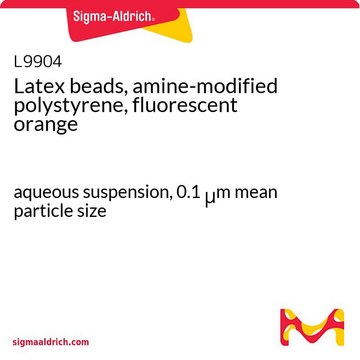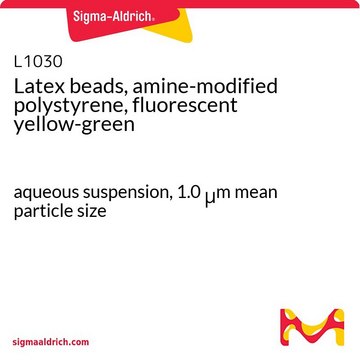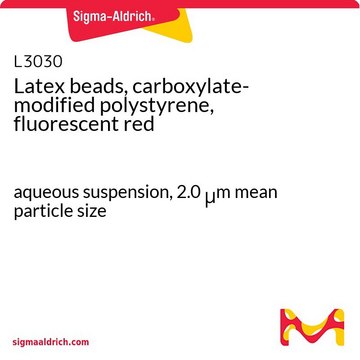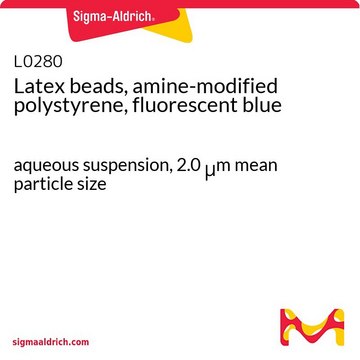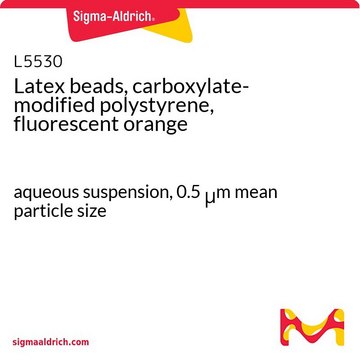L0780
Latex beads, amine-modified polystyrene, fluorescent blue
aqueous suspension, 0.05 μm mean particle size
Faça loginpara ver os preços organizacionais e de contrato
About This Item
Produtos recomendados
forma
aqueous suspension
Nível de qualidade
composição
Solids, 2.5%
técnica(s)
cell based assay: suitable
tamanho médio de partícula
0.05 μm
fluorescência
λex ~360 nm; λem ~420 nm
aplicação(ões)
cell analysis
Procurando produtos similares? Visita Guia de comparação de produtos
Aplicação
Latex beads, amine-modified polystyrene, fluorescent blue has been used:
- to study its effects on the concentration-response relationship of bacterial cell viability
- in the preparation of nanoparticles
- as a model nanoparticle to study interactions with human blood and platelets
Ações bioquímicas/fisiológicas
Polystyrene latex beads can be used to create latex agglutination systems. Polystyrene latex beads have been used to study the transmission of Mycobacterium leprae, the causative pathogen of leprosy, as well as to develop a method for mass screening for both pulmonary and extrapulmonary tuberculosis.
Código de classe de armazenamento
10 - Combustible liquids
Classe de risco de água (WGK)
WGK 3
Ponto de fulgor (°F)
Not applicable
Ponto de fulgor (°C)
Not applicable
Certificados de análise (COA)
Busque Certificados de análise (COA) digitando o Número do Lote do produto. Os números de lote e remessa podem ser encontrados no rótulo de um produto após a palavra “Lot” ou “Batch”.
Já possui este produto?
Encontre a documentação dos produtos que você adquiriu recentemente na biblioteca de documentos.
Os clientes também visualizaram
J-M Gineste et al.
Journal of microscopy, 243(2), 172-178 (2011-03-08)
The forward scattering of light in a conventional inverted optical microscope by nanoparticles ranging in diameter from 10 to 50nm has been used to automatically and quantitatively identify and track their location in three-dimensions with a temporal resolution of 200ms.
Optical signatures of small nanoparticles in a conventional microscope.
Eann A Patterson et al.
Small (Weinheim an der Bergstrasse, Germany), 4(10), 1703-1706 (2008-09-10)
INDUCTION OF EPIGENETIC RESPONSE TO AMINO-MODIFIED POLYSTYRENE NANOPARTICLES IN HUMAN CELLS
Koprinarova M, et al.
Comparative clinical pathology, 71(10) (2018)
Catherine McGuinnes et al.
Toxicological sciences : an official journal of the Society of Toxicology, 119(2), 359-368 (2010-12-03)
There is evidence that nanoparticles (NP) can enter the bloodstream following deposition in the lungs, where they may interact with platelets. Polystyrene latex nanoparticles (PLNP) of the same size but with different surface charge-unmodified (umPLNP), aminated (aPLNP), and carboxylated (cPLNP)-were
J Geys et al.
Toxicology letters, 160(3), 218-226 (2005-09-03)
Recent studies indicate that inhaled ultrafine particles can pass into the circulation. To study this translocation in an in vitro model three types of pulmonary epithelial cells were examined. The integrity of the cell monolayer was verified by measuring the
Nossa equipe de cientistas tem experiência em todas as áreas de pesquisa, incluindo Life Sciences, ciência de materiais, síntese química, cromatografia, química analítica e muitas outras.
Entre em contato com a assistência técnica
